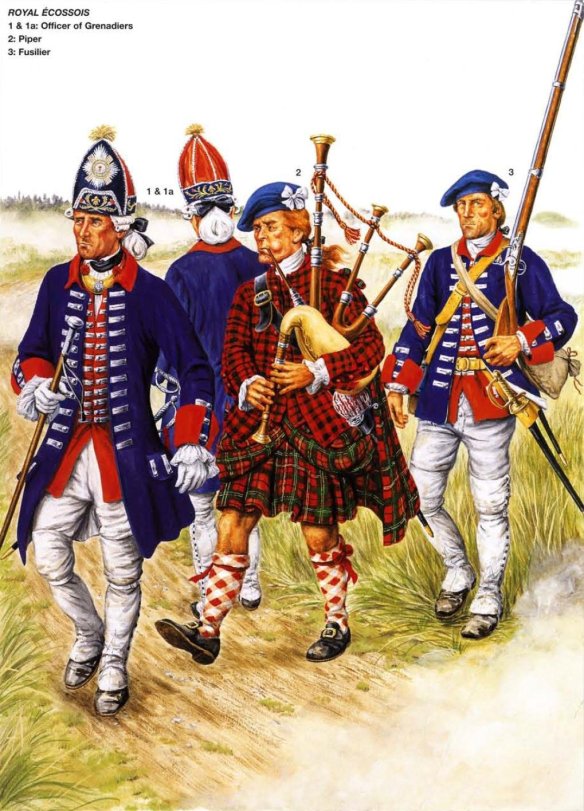Royal Ecossais at Culloden Moor – the one last epic stand.
The preparation of the Scottish regiment at Lille was designed to assist James’s invasion of Britain in the summer campaigning season of 1692. However, on 3 October 1691, William III had signed the Treaty of Limerick, marking the formal end of the conflict in Ireland. Louis XIV had given up on Jacobite resistance in Ireland even earlier: he had agreed to send only enough supplies to keep the war going as a diversion—which probably accounts for the lack of interest in, and respect for, the efforts of the recruiters at Lille.
King James still believed he could strike out at William in Flanders, where the prince would be busy directing his British and Dutch regiments. Theoretically, James had at his disposal over 12,000 Irish soldiers billeted in Brittany, as well as the English and Scottish volunteers at Lille. However, he had lost effective control of the Irish who were receiving their orders as part of the French Army. William’s forces in Britain, fearing another Jacobite attempt in 1692, stationed 10,000 men in a forty-mile radius of Portsmouth and had a further 4,000 infantry on stand-by in Flanders. Louis XIV considerably harassed the forces of William in the Low Countries, where the prince lost the fortress of Namur to the French in the same year. The success of this operation was keenly hoped for by a number of highly placed British officers who served King William. Some of them colluded actively with James for his restoration: the most prominent of them was Lord Churchill, who may, in January 1692, have betrayed to the French the planned English invasion of Dunkirk.
Churchill’s duplicity marks the commonest flaw of James’s support base in the years immediately after the ‘Glorious Revolution’, whose signature was irresolute conduct caused by the consistent failure to co-ordinate the different sources of Jacobite resistance. However the activities of the recruiters at Lille demonstrate the deep divisions which existed among the soldiers who owed William allegiance and whom he could send to Flanders to continue his war against Louis XIV. Despite many promises, the fact that less than two hundred defectors could be gathered at Lille between 1690 and 1691, can be attributed to the confused or divided loyalty of many of James’s former subjects combined with the strong policing activities of William’s few loyal officers.
Many British soldiers felt that William’s treatment of James was scandalous and were militant enough to express their disapproval through desertion, but few subalterns (and far fewer rank-and-file soldiers) acted on this feeling. The majority of the soldiers who went out of their way to aid James came from Dumbarton’s old regiment. This was due to three factors: first, the long history of that regiment in supporting the Stuart Crown; second, the unit’s association with Roman Catholicism, in the person of its commander, and French service; and, third, the deeply conservative social and political philosophy of its Scottish officer corps. All three of these factors were present in the beliefs and actions of the recruiters at Lille, and they account for the fact that the majority of the deserters they procured were experienced Scottish officers from regiments with a strongly conservative and loyalist character. Some of these recruits were Roman Catholic, but whether Catholic or not, they were all outraged by what they saw as the outlandish and scandalous treatment of their anointed king.
Significantly, the Jacobite army at Lille represents the last attempt to form a Scottish unit (with a sizeable Scottish component at rank-and-file level) abroad. No distinctly Scottish regiments served abroad after 1688 that were not (in some way) attached to a larger British Army. In this way it is perfectly true to say that William’s ascendancy in Britain marks the end of the tradition of private Scottish military service in foreign parts. Certainly, individual Scottish soldiers continued to serve abroad throughout the eighteenth century, not least because many of them espoused the cause of the ‘king over the water’, as King James and his successors were called. Many, however, did so for exactly those reasons that were common to earlier soldiers, including the quest for honour and profit: but none commanded regiments of their compatriots. The one exception might be the Scottish officers of the Anglo-Dutch Brigade, which survived in the United Provinces into the eighteenth century. However, the records of this unit suggest that, after 1700, few of the rank-and-file members of the regiments were Scots and the close Anglo-Dutch co-operation of the 1690s makes the ‘foreign’ status of the unit questionable. Therefore, if a trend away from independent units towards state-funded and standing forces is to be seen in this period, its culmination came directly from the interventionist political circumstances surrounding the ‘Glorious Revolution’ of 1688, the revocation of the Edict of Nantes, and the wars of the Grand Alliance (1689–97). It did not come from what might be called ‘natural’ or ‘evolutionary’ developments fostered by, among other things, changes in military technology.
